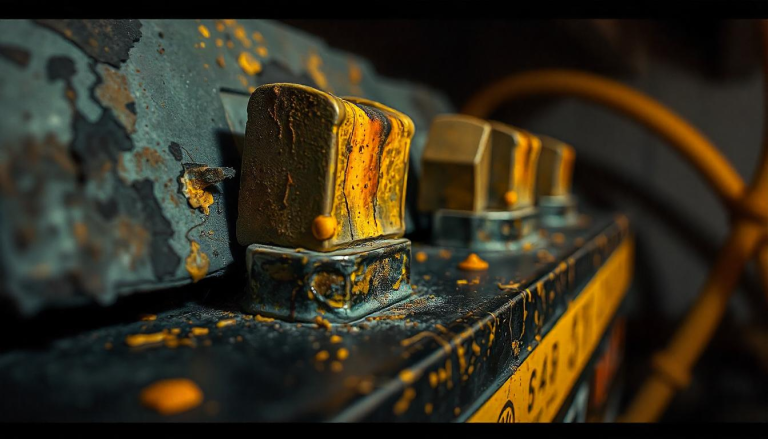Battery corrosion is a common problem that can damage electronics, cars, and power tools if left untreated. The white, crusty buildup around battery terminals is caused by leaking battery acid, which can lead to poor performance, connectivity issues, and even permanent damage.
The good news? You can easily clean battery corrosion at home using simple household items like vinegar or baking soda!
In this guide, we’ll cover:
✔ What causes battery corrosion
✔ How to clean corrosion from batteries & devices
✔ How to prevent future battery leaks
Let’s get started! ⚡🔋
🔍 What Causes Battery Corrosion?
Battery corrosion happens when battery acid leaks and reacts with metal surfaces, forming a white, bluish-green, or brownish powder around battery terminals.
Common Causes of Battery Corrosion:
✔ Old or Expired Batteries – Over time, batteries naturally degrade and leak acid.
✔ Overcharging – Excess heat can cause acid leaks in rechargeable batteries.
✔ Extreme Temperatures – High heat or cold can weaken battery seals.
✔ Moisture & Humidity – Can speed up battery corrosion.
✔ Improper Storage – Keeping batteries loose or mixed can cause leaks.
🚨 Warning: Corroded batteries can damage your device permanently if not cleaned properly!
🛠️ How to Clean Battery Corrosion (Step-by-Step Guide)
📝 What You’ll Need:
✔ Gloves & Safety Glasses (for protection)
✔ Baking Soda & Water OR White Vinegar/Lemon Juice
✔ Cotton Swabs or Old Toothbrush
✔ Paper Towels or Cloth
✔ Small Bowl for Mixing Solution
📌 Safety Tip: Battery acid can be harmful, so always wear gloves and eye protection before handling corroded batteries!
Method 1: Cleaning Battery Corrosion with Baking Soda (Best for Car Batteries)
✔ Best for: Car batteries, larger battery terminals
📌 Why It Works: Baking soda neutralizes battery acid, making it safe to remove.
Step-by-Step Instructions:
1️⃣ Remove the Battery – If cleaning a car battery, disconnect the negative terminal (-) first, then the positive (+).
2️⃣ Make a Baking Soda Paste – Mix 1 tablespoon of baking soda with 2 tablespoons of water to create a thick paste.
3️⃣ Apply to Corroded Areas – Use an old toothbrush or cloth to spread the paste over corrosion.
4️⃣ Let It Sit for 5-10 Minutes – This allows the baking soda to neutralize the acid.
5️⃣ Scrub Gently – Use the toothbrush or cotton swab to remove loose corrosion.
6️⃣ Wipe Clean & Dry – Use a damp cloth to remove residue, then dry completely.
7️⃣ Reconnect Battery – If working on a car battery, reconnect the positive terminal (+) first, then the negative (-).
✅ Best For: Car batteries, marine batteries, lawnmowers
Method 2: Cleaning Battery Corrosion with Vinegar or Lemon Juice (Best for Electronics)
✔ Best for: Remote controls, flashlights, toys, and small devices
📌 Why It Works: Vinegar and lemon juice dissolve corrosion without damaging electronics.
Step-by-Step Instructions:
1️⃣ Remove the Batteries – Discard leaking batteries safely (see disposal guide below).
2️⃣ Dip a Cotton Swab in Vinegar or Lemon Juice – Apply directly to corroded areas.
3️⃣ Let It Sit for a Few Minutes – This helps break down battery acid residue.
4️⃣ Scrub Gently – Use a soft brush or cotton swab to remove corrosion.
5️⃣ Wipe Dry with a Clean Cloth – Ensure the battery compartment is completely dry before inserting new batteries.
✅ Best For: TV remotes, game controllers, hearing aids, household electronics
⚠️ How to Safely Dispose of Corroded Batteries
🚨 Never throw corroded batteries in regular trash! Battery acid is hazardous and needs to be disposed of properly.
✔ Take batteries to a battery recycling center (Home Depot, Best Buy, or local waste facilities).
✔ Wrap corroded batteries in plastic or a sealed bag before disposal.
✔ Never burn batteries—they can explode!
📌 Pro Tip: Check your city’s recycling program for drop-off locations.
🔒 How to Prevent Battery Corrosion
Want to avoid dealing with battery corrosion again? Follow these simple tips:
✔ Use High-Quality Batteries – Cheap batteries leak faster. Stick with brands like Duracell, Energizer, or Panasonic.
✔ Remove Batteries When Not in Use – If you’re storing electronics for long periods, take the batteries out.
✔ Store Batteries in a Cool, Dry Place – Avoid extreme temperatures or humid areas.
✔ Clean Battery Terminals Regularly – Wipe battery compartments with a dry cloth every few months.
✔ Use Dielectric Grease for Car Batteries – This prevents moisture buildup and corrosion.
✔ Check Expiry Dates Before Installing Batteries – Old batteries are more likely to leak.
📌 Pro Tip: If you’re storing loose batteries, keep them in their original packaging or a battery case to prevent leaks.
🔍 Frequently Asked Questions (FAQs)
Q: Is battery corrosion dangerous to touch?
✔ Yes, battery acid can irritate skin and eyes. Always wear gloves and wash hands after handling corroded batteries.
Q: Can I use WD-40 to clean battery terminals?
✔ Yes! WD-40 can help remove battery corrosion, but always wipe it completely dry before reconnecting batteries.
Q: Will corroded batteries still work?
❌ No! If batteries are leaking or corroded, replace them immediately to avoid damaging your device.
Q: Can I use water alone to clean battery corrosion?
❌ No! Water doesn’t neutralize battery acid—use baking soda or vinegar for safe cleaning.
🔚 Final Thoughts: Cleaning Battery Corrosion the Right Way
✔ Use baking soda for car batteries and vinegar for electronics.
✔ Always wear gloves and handle batteries safely.
✔ Prevent future corrosion by storing batteries properly and using high-quality brands.
By following these steps, you can restore your electronics, extend battery life, and avoid costly damage!
💬 Have you ever dealt with battery corrosion? What method worked best for you? Drop your tips in the comments! 🔋✨


